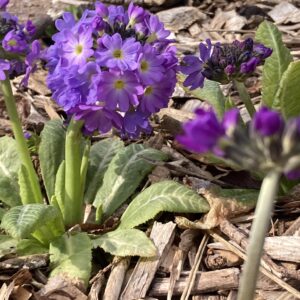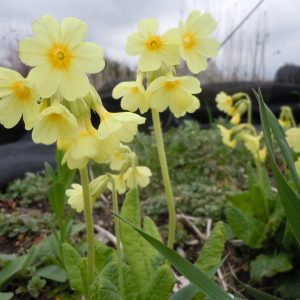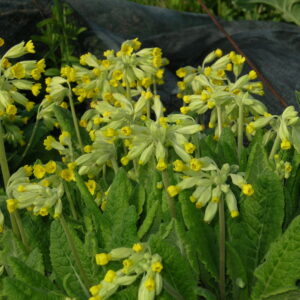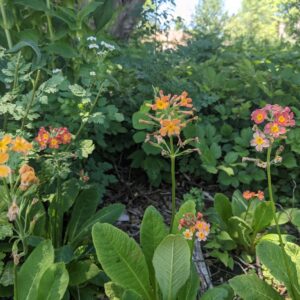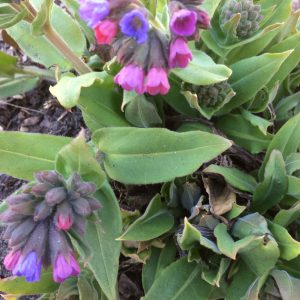Our Plants
Showing 449–456 of 587 results
-
Potentilla x tonguei Staghorn cinquefoil Z. 5-8
Apricot-yellow flowers with red centers bloom June-September
Apricot-yellow flowers with red centers bloom June-September.
Size: 6” x 12”
Care: Sun to part shade in moist well-drained soil
Awards: Royal Horticultural Society Award of Garden Merit.This is a cross of P. anglica and P. nepalensis which took place naturally in a garden. This Cinquefoil has been in gardens since at least 1839. Potentilla is Latin meaning “powerful” referring to historic medicinal properties since Hippocrates. We love its long, colorful blooms and neat habit.
-
Primula beesiana Candelabra primrose, Bee’s primrose Z 4-8
From 2-8 stems, each bearing a whorl of a dozen or so small, fuchsia-pink flowers encircling each leafless stem like a ballerina’s tutu,, then alternating with a leafless stem, the another whorl of flowers then another section of leafless stem in tiers, Each whorl blooms in succession from the bottom up.
From 2-8 stems, each bearing a whorl of a dozen or so small, fuchsia-pink flowers encircling each leafless stem like a ballerina’s tutu,, then alternating with a leafless stem, the another whorl of flowers then another section of leafless stem in tiers, Each whorl blooms in succession from the bottom up.
Size: 1’ x 1’
Care: part shade in moist or moist well-drained soil in neutral to acidic pH
Native: Sichuan and Yunnan provinces in SW China and Myranmar
Wildlife Value: attracts butterflies, bees and other pollinators
Awards: Royal Horticultural Society Award of Garden MeritPrimula means “first spring” in Italian. The common name “Bee’s” is not for the insect; it’s for the nursery that grew them on and sold them and funded Scottish collector George Forrest’s trip to China to hunt for plants. Forrest collected this around 1910. Naturalist Arthur Bulley (1861-1942) owned that nursery, Bees Ltd.
-
Primula denticulata Drumstick primula Z 3-8
A ball of flowers, like a lollipop, purple or blue with a yellow eye, atop each leafless stem, emerging from a base of wrinkled foliage. Flowers in spring.
A ball of flowers, like a lollipop, purple or blue with a yellow eye, atop each leafless stem, emerging from a base of wrinkled foliage. Flowers in spring.
Size: 12-18" x 12-18"
Care: Sun to shade in moist to moist well-drained soil.
Native: Afghanistan, N. Pakistan, across the Himalaya to Yunnan, Sichuan and Guizhou in China.Collected by Dr. Frances Buchanan “in moist hills about Chitlong in Nepal.” Exotic Botany, vol. 2 (1805), Sir James Edward Smith (1759-1828).
-
Primula elatior Oxlip Z 4-9
Nodding trumpets of soft yellow flowers with a dark yellow center atop upright stems
OUT OF STOCK
Nodding trumpets of soft yellow flowers with a dark yellow center atop upright stems
Size: 10” x 10”
Care: part shade in moist to moist well-drained soil
Native: Europe
Wildlife Value: Deer and rabbit resistant. Attracts bees, butterflies, some moths and hummingbirds.
Awards: Plant Select® Central Rocky Mountain region; Royal Botanical Society Award of Garden MeritPrimula is from Italian “primavera” meaning first spring. Elatior means “tall”, all things being relative it’s taller than some Primulas but not very tall. In gardens since at least 1765. According to Philip Miller, Gardener’s Dictionary 1768, “they are much used in medicine.” Grown at America’s 1st botanic garden, Elgin Botanic Garden 1811.
-
Primula japonica Japanese primrose, Candelabra primrose in Japan called Kurin-sou Z 4-8
White, red, pink or purple primrose flowers in early summer. Each bearing a whorl of 3-6 flowers encircling each leafless stem, alternating with a bare section of leafless stem, then another whorl of flowers, then another section of bare stem, in tiers, like a ballerina’s tutu with bare midriff between. Basal mound of crinkled foliage
OUT OF STOCK
White, red, pink or purple primrose flowers in early summer. Each bearing a whorl of 3-6 flowers encircling each leafless stem, alternating with a bare section of leafless stem, then another whorl of flowers, then another section of bare stem, in tiers, like a ballerina’s tutu with bare midriff between. Basal mound of crinkled foliage
Size: 18”x 18”
Care: sun to part shade in moist, acidic soil. Moist soil important.
Native: Japan
Awards: Elisabeth Carey Miller Botanical Garden Great Plant Pick.Introduced to Western gardens by Robert Fortune, (1812-1889) English plant collector, 1870 but Jan 1876 issue of The Garden reported that it was “introduced some years ago by Mr. Bull…,” English plantsman. Listed in the 1873 catalog of Leichtlin’schen Gartens in Baden-Baden. British plant guru Wm. Robinson (1838-1895)called this “one of the best and most amiable of the species.” (1933)
-
Primula veris Cowslip Z 3-8
Sunniest of yellow trumpet flowers announce the beginning of spring atop short, leafless stems
Sunniest of yellow trumpet flowers announce the beginning of spring atop short, leafless stems
Size: 8" x 8"
Care: part shade in moist to moist well-drained soil.
Native: Europe
Awards: England’s Royal Horticultural Society Award of Merit and Elisabeth Carey Miller Botanical Garden Great Plant PicksPrimula is Italian “primavera” meaning first spring. Veris is redundant, meaning flowers in spring. According to legend, Cowslip decorated the entrance to Norse goddess Fryda’s palace. The blossoms were used to make wine; a recipe from the 1700’s called for water, sugar, lemon juice, egg whites and a “peck of cowslips.” Culpepper, a 1500’s herbalist, reported that cowslip extract made women “more beautiful.” Cowslip was a favorite Shakespearean plant. Grown at America’s 1st botanic garden, Elgin Botanic Garden 1811. Jefferson received cowslip seeds in 1824. Pressed specimen in Emily Dickinson’s herbarium.
-
Primula x bulleesiana Candelabra primrose Z 4-7
From clustered stems, each bearing a whorl of 3-6 flowers encircling each leafless stem alternating with a bare section of leafless stem, then another whorl of flowers, then another section of bare stem, in tiers, like a ballerina’s tutu with bare midriff between. Each whorl blooms in succession from the bottom up. This blooms June – July in a rainbow of colors - red, orange, rose, cream, lavender and purple.
OUT OF STOCK
From clustered stems, each bearing a whorl of 3-6 flowers encircling each leafless stem alternating with a bare section of leafless stem, then another whorl of flowers, then another section of bare stem, in tiers, like a ballerina’s tutu with bare midriff between. Each whorl blooms in succession from the bottom up. This blooms June – July in a rainbow of colors – red, orange, rose, cream, lavender and purple.
Size: 18-24” x 12-18”
Care: Sun to part shade in moist to well-drained soil
Wildlife Value: Attracts butterflies. Deer resistant
Awards: Royal Horticultural Society Award of Garden Merit 1993Hybrid cross between Primula bulleyana and Primula beesiana (both parents are native to the Himalayas and China).
Collected in China, introduced to Britain in 1906 -
Pulmonaria angustifolia Narrow-leaf lungwort, Blue cowslip Z 4-8
One of the earliest to flower - Pink turning azure blue, trumpet-shaped flowers in April- May. Fuzzy foliage.
Welcome spring with this very early flower – Pink trumpet-shaped flowers turn deep blue in early sprng.. Fuzzy foliage.
Size: 12”x 12”
Care: full to part shade in moist to moist well-drained soil.
Native: Austria & Hungary.
Wildlife Value: walnut and deer tolerant. Early source of nectar for bees.
Awards: Royal Horticultural Society Award of Garden MeritAngustifolia means “narrow leaves.” Grown in gardens before 1590’s.



